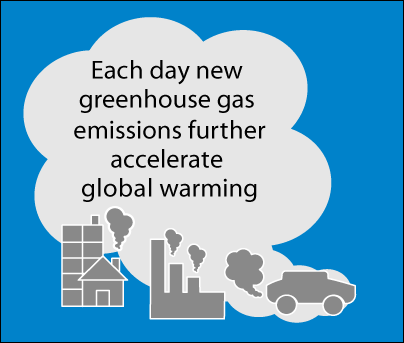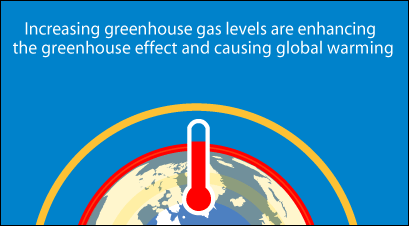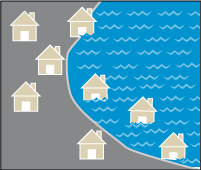Global warming is the current increase in temperature of the Earth's surface (both land and water) as well as it's atmosphere. Average temperatures around the world have risen by 0.75°C (1.4°F) over the last 100 years about two thirds of this increase has occurred since 1975. In the past, when the Earth experienced increases in temperature it was the result of natural causes but today it is being caused by the accumulation of greenhouse gases in the atmosphere produced by human activities.
The natural greenhouse effect maintains the Earth's temperature at a safe level making it possible for humans and many other lifeforms to exist. However, since the Industrial Revolution human activities have significantly enhanced the greenhouse effect causing the Earth's average temperature to rise by almost 1°C. This is creating the global warming we see today. To put this increase in perspective it is important to understand that during the last ice age, a period of massive climate change, the average temperature change around the globe was only about 5°C.
A long series of scientific research and international studies has shown, with more than 90% certainty, that this increase in overall temperatures is due to the greenhouse gases produced by humans. Activities such as deforestation and the burning of fossil fuels are the main sources of these emissions. These findings are recognized by the national science academies of all the major industrialized countries.
Global warming is affecting many places around the world. It is accelerating the melting of ice sheets, permafrost and glaciers which is causing average sea levels to rise. It is also changing precipitation and weather patterns in many different places, making some places dryer, with more intense periods of drought and at the same time making other places wetter, with stronger storms and increased flooding. These changes have affected both nature as well as human society and will continue to have increasingly worse effects if greenhouse gas emissions continue to grow at the same pace as today.

The cause of global warming is the increasing quantity of greenhouse gases in the our atmosphere produced by human activities, like the burning of fossil fuels or deforestation. These activities produce large amounts of greenhouse gas emissions which is causing global warming. Greenhouse gases trap heat in the Earth's atmosphere to keep the planet warm enough to sustain life, this process is called the greenhouse effect. It is a natural process and without these gases, the Earth would be too cold for humans, plants and other creatures to live.
The natural greenhouse effect exists due to the balance of the major types of greenhouse gases. However, when abnormally high levels of these gases accumulate in the air, more heat starts getting trapped and leads to the enhancement of the greenhouse effect. Human-caused emissions have been increasing greenhouse levels which is raising worldwide temperatures and driving global warming.
Greenhouse gas emissions and the enhanced greenhouse effect
Greenhouse gases are produced both naturally and through human activities. Unfortunately, greenhouse gases generated by human activities are being added to the atmosphere at a much faster rate than any natural process can remove them.
Global levels of greenhouse gases have increased dramatically since the dawn of the Industrial Revolution in the 1750s. Only a small group of human activities are causing the concentration of the main greenhouse gases (carbon dioxide, methane, nitrous oxide and fluorinated gases) to rise:
- The majority of man-made carbon dioxide emissions is from the burning of fossil fuels such as coal and oil so that humans can power various vehicles, machinery, keep warm and create electricity. Other important sources come from land-use changes (ex: deforestation) and industry (ex: cement production).
- Methane is created by humans during fossil fuel production and use, livestock and rice farming, as well as landfills.
- Nitrous oxide emissions are mainly caused by the use of synthetic fertilizers for agriculture, fossil fuel combustion and livestock manure management.
- Fluorinated gases are used mainly in refrigeration, cooling and manufacturing applications.
Deforestation
Deforestation has become a massive undertaking by humans and transforming forests into farms has a significant number of impacts as far as greenhouse gas emissions are concerned. For centuries, people have burned and cut down forests to clear land for agriculture. This has a double effect on the atmosphere both emiting carbon dioxide into the atmosphere and simultaneously reducing the number of trees that can remove carbon dioxide from the air.
When forested land is cleared, soil disturbance and increased rates of decomposition in converted soils both create carbon dioxide emissions. This also increases soil erosion and nutrient leaching which can further reduces the area's ability to act as a carbon sink.
Global warming is damaging the Earth's climate as well as the physical environment. One of the most visible effects of global warming can be seen in the Arctic as glaciers, permafrost and sea ice are melting rapidly. Global warming is harming the environment in several ways including:
- Desertification
- Increased melting of snow and ice
- Sea level rise
- Stronger hurricanes and cyclones
Desertification
Increasing temperatures around the world are making arid and semi-arid areas even more dry than before. Current research is also showing that the water cycle is changing and rainfall patterns are shifting to make areas that are already dry even drier. This is causing water shortages and an intense amount of distress to the over 2.5 million people in dry regions which are degrading into desert. This process is called desertification.
Increased melting of snow and ice
Around the world, snow and ice is melting at a much faster pace than in the past. This has been seen in the Alps, Himalayas, Andes, Rockies, Alaska and Africa but is particularly true at the Earth's poles.
Perennial ice cover in the Arctic is melting at the rate of 11.5% per decade and the thickness of the Arctic ice has decreased by 48% since the 1960s. During the past 30 years, more than a million square miles of sea ice has vanished, an area equivalent to the size of Norway, Denmark and Sweden combined. The continent of Antarctica has been losing more than 100 cubic kilometers (24 cubic miles) of ice per year since 2002. Since 2010, the Antarctic ice melt rate has doubled.
Sea level rise
The Earth's sea level has risen by 21 cm (8 inches) since 1880. The rate of rise is accelerating and is now at a pace that has not been seen for at least 5000 years. Global warming has caused this by affecting the oceans in two ways: warmer average temperatures cause ocean waters to expand (thermal expansion) and the accelerated melting of ice and glaciers increase the amount of water in the oceans.
Stronger hurricanes and cyclones
Tropical cyclone activity has seen an obvious upswing trend since the early 1970s. Interestingly, this matches directly with an observed rise in the oceans' temperature over the same period of time. Since then, the Power Dissipation Index which measures the destructive power of tropical cyclones has increased in the Pacific by 35% and in the Atlantic it has nearly doubled. Global warming also increases the frequency of strong cyclones. Every 1 degree C increase in sea surface temperature results in a 31% increase in the global frequency of category 4 and 5 storms.






